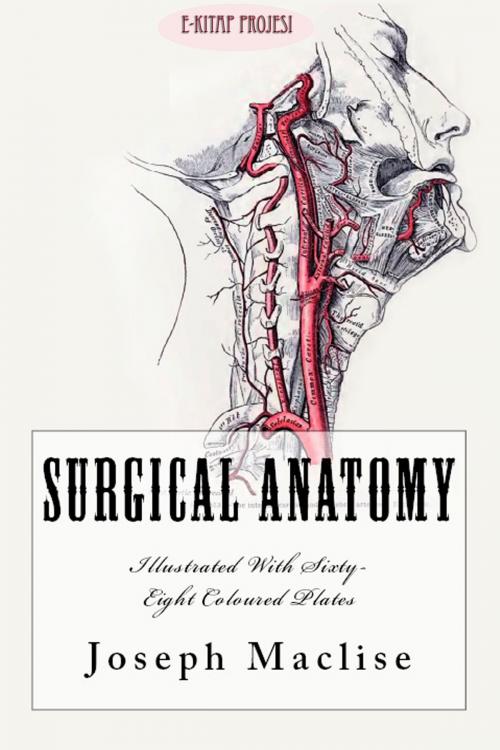Surgical Anatomy
"With Sixty-Eight Coloured Plates"
Nonfiction, Science & Nature, Science, Biological Sciences, Human Physiology| Author: | Joseph Maclise | ISBN: | 9786059285346 |
| Publisher: | eKitap Projesi | Publication: | October 1, 2015 |
| Imprint: | eKitap Projesi | Language: | English |
| Author: | Joseph Maclise |
| ISBN: | 9786059285346 |
| Publisher: | eKitap Projesi |
| Publication: | October 1, 2015 |
| Imprint: | eKitap Projesi |
| Language: | English |
The object of this work is to present to the student of medicine and the practitioner removed from the schools, a series of dissections demonstrative of the relative anatomy of the principal regions of the human body. Whatever title may most fittingly apply to a work with this intent, whether it had better be styled surgical or medical, regional, relative, descriptive, or topographical anatomy, will matter little, provided its more salient or prominent character be manifested in its own form and feature. The work, as I have designed it, will itself show that my intent has been to base the practical upon the anatomical, and to unite these wherever a mutual dependence was apparent.
That department of anatomical research to which the name topographical strictly applies, as confining itself to the mere account of the form and relative location of the several organs comprising the animal body, is almost wholly isolated from the main questions of physiological and transcendental interest, and cannot, therefore, be supposed to speak in those comprehensive views which anatomy, taken in its widest signification as a science, necessarily includes.
While the anatomist contents himself with describing the form and position of organs as they appear exposed, layer after layer, by his dissecting instruments, he does not pretend to soar any higher in the region of science than the humble level of other mechanical arts, which merely appreciate the fitting arrangement of things relative to one another, and combinative to the whole design of the form or machine of whatever species this may be, whether organic or inorganic. The descriptive anatomist of the human body aims at no higher walk in science than this, and hence his nomenclature is, as it is, a barbarous jargon of words, barren of all truthful signification, inconsonant with nature, and blindly irrespective of the cognitio certa ex principiis certis exorta.
Still, however, this anatomy of form, although so much requiring purification of its nomenclature, in order to clothe it in the high reaching dignity of a science, does not disturb the medical or surgical practitioner, so far as their wants are concerned. Although it may, and actually does, trammel the votary who aspires to the higher generalizations and the development of a law of formation, yet, as this is not the object of the surgical anatomist, the nomenclature, such as it is, will answer conveniently enough the present purpose.
The anatomy of the human form, contemplated in reference to that of all other species of animals to which it bears comparison, constitutes the study of the comparative anatomist, and, as such, establishes the science in its full intent. But the anatomy of the human figure, considered as a species, per se, is confessedly the humblest walk of the understanding in a subject which, as anatomy, is relationary, and branches far and wide through all the domain of an animal kingdom. While restricted to the study of the isolated human species, the cramped judgment wastes in such narrow confine; whereas, in the expansive gaze over all allying and allied species, the intellect bodies forth to its vision the full appointed form of natural majesty; and after having experienced the manifold analogies and differentials of the many, is thereby enabled, when it returns to the study of the one, to view this one of human type under manifold points of interest, to the appreciation of which the understanding never wakens otherwise. If it did not happen that the study of the human form (confined to itself) had some practical bearing, such study could not deserve the name of anatomical, while anatomical means comparative, and whilst comparison implies inductive reasoning.
ABOUT AUTHOR:
Joseph Maclise:
FELLOW OF THE ROYAL COLLEGE OF SURGEONS
I INSCRIBE THIS WORK TO THE GENTLEMEN
WITH WHOM AS A FELLOW-STUDENT I WAS ASSOCIATED AT THE
London University College:
AND IN AN ESPECIAL MANNER, IN THEIR NAME AS WELL AS MY OWN,
I AVAIL MYSELF OF THE OPPORTUNITY TO RECORD, ON THIS PAGE,
ALBEIT IN CHARACTERS LESS IMPRESSIVE THAN THOSE WHICH ARE
WRITTEN ON THE LIVING TABLET OF MEMORY,
THE DEBT OF GRATITUDE WHICH WE OWE TO THE LATE
SAMUEL COOPER, F.R.S., AND ROBERT LISTON, F.R.S.,
TWO AMONG THE MANY DISTINGUISHED PROFESSORS OF THAT
INSTITUTION, WHOSE PUPILS WE HAVE BEEN,
AND FROM WHOM WE INHERIT THAT BETTER POSSESSION THAN LIFE
ITSELF, AN ASPIRATION FOR THE LIGHT OF SCIENCE.
JOSEPH MACLISE.
The object of this work is to present to the student of medicine and the practitioner removed from the schools, a series of dissections demonstrative of the relative anatomy of the principal regions of the human body. Whatever title may most fittingly apply to a work with this intent, whether it had better be styled surgical or medical, regional, relative, descriptive, or topographical anatomy, will matter little, provided its more salient or prominent character be manifested in its own form and feature. The work, as I have designed it, will itself show that my intent has been to base the practical upon the anatomical, and to unite these wherever a mutual dependence was apparent.
That department of anatomical research to which the name topographical strictly applies, as confining itself to the mere account of the form and relative location of the several organs comprising the animal body, is almost wholly isolated from the main questions of physiological and transcendental interest, and cannot, therefore, be supposed to speak in those comprehensive views which anatomy, taken in its widest signification as a science, necessarily includes.
While the anatomist contents himself with describing the form and position of organs as they appear exposed, layer after layer, by his dissecting instruments, he does not pretend to soar any higher in the region of science than the humble level of other mechanical arts, which merely appreciate the fitting arrangement of things relative to one another, and combinative to the whole design of the form or machine of whatever species this may be, whether organic or inorganic. The descriptive anatomist of the human body aims at no higher walk in science than this, and hence his nomenclature is, as it is, a barbarous jargon of words, barren of all truthful signification, inconsonant with nature, and blindly irrespective of the cognitio certa ex principiis certis exorta.
Still, however, this anatomy of form, although so much requiring purification of its nomenclature, in order to clothe it in the high reaching dignity of a science, does not disturb the medical or surgical practitioner, so far as their wants are concerned. Although it may, and actually does, trammel the votary who aspires to the higher generalizations and the development of a law of formation, yet, as this is not the object of the surgical anatomist, the nomenclature, such as it is, will answer conveniently enough the present purpose.
The anatomy of the human form, contemplated in reference to that of all other species of animals to which it bears comparison, constitutes the study of the comparative anatomist, and, as such, establishes the science in its full intent. But the anatomy of the human figure, considered as a species, per se, is confessedly the humblest walk of the understanding in a subject which, as anatomy, is relationary, and branches far and wide through all the domain of an animal kingdom. While restricted to the study of the isolated human species, the cramped judgment wastes in such narrow confine; whereas, in the expansive gaze over all allying and allied species, the intellect bodies forth to its vision the full appointed form of natural majesty; and after having experienced the manifold analogies and differentials of the many, is thereby enabled, when it returns to the study of the one, to view this one of human type under manifold points of interest, to the appreciation of which the understanding never wakens otherwise. If it did not happen that the study of the human form (confined to itself) had some practical bearing, such study could not deserve the name of anatomical, while anatomical means comparative, and whilst comparison implies inductive reasoning.
ABOUT AUTHOR:
Joseph Maclise:
FELLOW OF THE ROYAL COLLEGE OF SURGEONS
I INSCRIBE THIS WORK TO THE GENTLEMEN
WITH WHOM AS A FELLOW-STUDENT I WAS ASSOCIATED AT THE
London University College:
AND IN AN ESPECIAL MANNER, IN THEIR NAME AS WELL AS MY OWN,
I AVAIL MYSELF OF THE OPPORTUNITY TO RECORD, ON THIS PAGE,
ALBEIT IN CHARACTERS LESS IMPRESSIVE THAN THOSE WHICH ARE
WRITTEN ON THE LIVING TABLET OF MEMORY,
THE DEBT OF GRATITUDE WHICH WE OWE TO THE LATE
SAMUEL COOPER, F.R.S., AND ROBERT LISTON, F.R.S.,
TWO AMONG THE MANY DISTINGUISHED PROFESSORS OF THAT
INSTITUTION, WHOSE PUPILS WE HAVE BEEN,
AND FROM WHOM WE INHERIT THAT BETTER POSSESSION THAN LIFE
ITSELF, AN ASPIRATION FOR THE LIGHT OF SCIENCE.
JOSEPH MACLISE.















